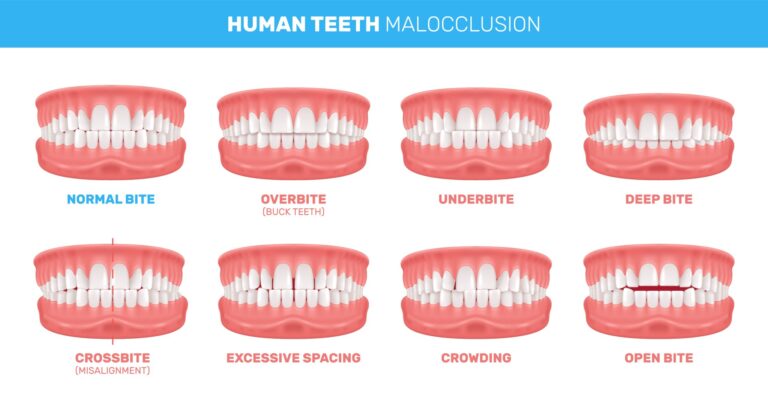When we talk about dental issues, one of the most common terms that comes up is malocclusions. Out of all dental issues, this is the most common in both children and adults. But what is malocclusion? Let’s find out.
What is Malocclusion?
Malocclusion essentially means that you have a bad bite. But this doesn’t mean you have messed up teeth! It just means that your upper and lower teeth, or your upper and lower jaw, do not align like they are supposed to. There are several causes of malocclusions, which we shall be discussing later in this article. Not only does this common dental issue affect your dental health negatively by causing decay, cavities, plaque, damage to the enamel, or gum disease, but it can also create problems in speaking, chewing, and masticating food.
In this article, we shall be covering malocclusion classes, types, symptoms, causes, diagnoses, and subsequent treatment options. Keep reading to find out more.
What Are the Three Types of Malocclusion Classes?
3 classes of malocclusions are found in dental practices. They are divided into various subcategories, listed in the information below:
Class I Malocclusion
Class 1 malocclusion, also known as class 1 occlusion, or class 1 bite is an overlap of upper teeth over the lower teeth and can be fixed with minor malocclusion treatment. Class I malocclusion has 3 types. Type 1 involves teeth leaning inwards. Towards each other. In type 2, lower teeth are angled towards the tongue, and upper teeth stick out in narrow arches. Type 3 involves the upper teeth being crowded and leaning towards the tongue.
Class II Malocclusion
Class 2 malocclusion, also known as class 2 occlusion and class 2 bite, involves the upper teeth sticking out over the lower teeth as well. But this malocclusion of teeth is severe enough to need early-onset orthodontic treatment, over a long period. Class 2 malocclusion has 2 divisions. Upper teeth lean towards the lips in division 1. In division 2, the upper central incisors lean towards the tongue.
Class III Malocclusion
Class III malocclusion, also known as class 3 occlusion and class 3 bite is a type of underbite where the lower teeth stick out over the upper teeth. Class 3 malocclusion is divided into 3 types, just like Class I. In type 1, an abnormally shaped arch is formed by teeth. In type 2, the lower front teeth are pointed towards the tongue. In type 3, the abnormalities are in the upper arch, and the upper teeth are angled towards the tongue.
What are Different Types of Malocclusion?
Now that we understand the various classes, we can delve deeper into the various types of malocclusions that are the subsets of these classes.
Overcrowding
Lack of space caused by crooked or overlapping teeth is referred to as overcrowding, a very commonly found dental malocclusion.
Improper Spacing
We all need space between our teeth, as it cannot be too much or too little. If the spacing between teeth is improper, it can adversely impact the eruption of permanent teeth.
Openbite
Openbite is a condition where the upper and lower teeth do not align properly, causing a gap to be left when we close our mouth, which can impact the shape of our jaw as well. It can occur on any side of your mouth.
Overjet
Overjet is a kind of overbite where the top of the teeth extend outwards horizontally, and it may cause issues while speaking, in jaw structure, chewing, and masticating food.
Overbite
An overbite is when the front teeth jut out abnormally, and overlap the lower teeth too much, often causing gum recession and causing the lower teeth to hit the roof of the mouth. It is one of the most commonly occurring dental issues found in the population.
Underbite
It is the opposite of an overbite, where the lower teeth jut out abnormally, far beyond where the upper teeth rest. This is also known as an anterior crossbite.
Crossbite
A crossbite can happen on either or both sides of the jaw when the upper front teeth are biting right inside the lower teeth. The condition can also affect your front or back teeth.
Diastema
Now seen as a symbol of cheekiness and beauty, a diastema is a dental malocclusion that refers to the space between two adjacent teeth.
Impacted Tooth
Impacted teeth are teeth that cannot erupt from your gums naturally. This type of malocclusion needs to be operated upon.
Missing Tooth
Also known as hypodontia, this condition occurs as a result of trauma or improper development of teeth.
What Causes Malocclusion?
Now that we understand the various types of malocclusions, let us understand what causes them. Malocclusions are usually an inherited condition. This means it can be passed down from one generation to the next. They can either be inherited genetically or acquired through an external condition. Some external conditions that may cause malocclusions are:
- Prolonged bottle feeding in early childhood
- Cleft lip or cleft palate
- Frequent use of pacifiers beyond a certain age
- Excessive thumb-sucking during childhood
- Injuries to the jaw caused by accidents, which lead to misalignment
- Mouth/jaw tumors
- Impacted teeth caused due to improper tooth development during early childhood
- Improperly fitted dental devices like crowns, fillings, braces, retainers, etc.
- Enlarged tonsils or adenoids leading to airway obstruction
What are the Typical Symptoms of Malocclusion?
Malocclusions are comparatively easy to spot. Mostly, they will contribute to altering your appearance. Some symptoms of malocclusions are:
- Abnormal alignment of teeth
- Abnormal appearance of the face
- Difficulty or discomfort when biting or chewing
- Difficulties while speaking, like lisps
- Mouth breathing
- Open bite
- Difficulty or discomfort when biting/chewing
How is malocclusion diagnosed?
The best way to diagnose dental issues is to regularly visit your dentist for timely check-ups. If you indeed have malocclusions, then your dentist may refer you to an orthodontist for treatment purposes.
If left untreated, malocclusion can cause various health issues. Apart from dental problems like tooth decay, loss, or gum disease, it can impact chewing and speech functions and even harm tooth enamel or jaw alignment. Moreover, untreated malocclusion can influence mental well-being, with research linking it to self-esteem issues. Some studies indicate that individuals with malocclusion may avoid social interactions and relationships due to appearance-related insecurities.
How to fix malocclusions?
Now that we know what is malocclusion, its causes, symptoms, types, and classes, let us understand how to treat them. There are several methods and treatment options available to fix malocclusions. Some of those options are listed below:
Orthodontic treatment
Braces:
Braces are the oldest, most reliable, and most trusted method of treating dental misalignments. They can either be metal, ceramic, or lingual, and they gradually straighten your teeth and realign them into proper shape. Usually, braces are recommended for children, to fix teeth alignment gradually at a young age.
Invisalign:
Invisalign is a new technology of clear aligner trays, which are shaped according to your teeth shape, that can help treat any kind of malocclusion. You have to wear these nearly invisible trays for 20-22 hours a day, and 15-18 trays of differing shapes gradually alter your teeth alignment. Treatments typically take up to 2 years, which may be a shorter duration as compared to braces.
Clear Correct:
Clear Correct is another method of clear aligner tray treatment that is similar to Invisalign but may be able to alter only certain types of malocclusions over time. Depending on the severity of your problem, your orthodontist will recommend you the best form of treatment
Surgical interventions
Orthognathic Surgery:
If your malocclusion is caused by jaw misalignment, you may need orthognathic surgery to reposition the placement of your jaws, to make them align properly and give you a good bite.
Jaw Repositioning Methods:
Jaw repositioning sometimes does not require major surgical procedures to be done, and can be done to realign your jaw into its ideal position.
Other Corrective Measures
Tooth Extraction:
Sometimes to align your teeth properly, patients who suffer from overcrowding may need to undergo tooth extraction procedures to remove extra or misaligned teeth. It is a simple procedure that will help you align your smile a lot better.
Palate Expanders:
Palate expanders are either a series of bands that are affixed to your molars or a clear aligner tray with a screw in the center, which are designed to help increase the width and depth of your jaw in case of misalignment. They can either be removable or permanently fixed for some time.
In this article, we have covered the various types of malocclusions, their causes, symptoms, classes, diagnostic methods, and various treatment options. We hope it can help you answer your queries about what is malocclusion, and its various subsets. Proper diagnosis and timely treatment, along with proper dental care, will help you take care of your teeth alignment issues.
If you are in Vails Gate, Monroe, NY, and are looking for an orthodontic solution to your dental issues, don’t hesitate to visit Vail Orthodontics for the best quality treatment and finest dental care solutions. Whether you need help with your braces treatments or your Invisalign needs, we will help you find a clear path toward getting that beautiful, aligned smile!
FAQs
- What does a normal bite look like?
A healthy bite consists of your upper teeth slightly overlapping your lower teeth, with the points of your upper and lower back teeth fitting into each other.
- Can Invisalign fix malocclusion?
Yes, it can! Invisalign is used to treat mild to moderate cases of malocclusions, along with some severe cases as well. This treatment of clear aligner trays is for individuals who are conscious about having visible dental treatment and gives excellent results.
- How to prevent malocclusion?
Generally, most malocclusions are genetic and cannot be prevented. You can discourage excessive use of pacifiers and thumb sucking by your children to prevent any malocclusion development. You can also ensure that you take your children for regular oral check-ups to identify any problems early on, and treat them effectively before they become severe.
- Can malocclusion cause TMJ?
Yes, some malocclusions, if very severe and not treated properly, may even cause Temporomandibular Joint Syndrome (TMJ) in children and adults.

Dr. Patel is an orthodontist and maintains a private practice in Rome, NY. He completed his undergraduate education at the Ohio State University. Then, he earned his Doctorate in Dental Medicine from the University of Pennsylvania School of Dental Medicine in Philadelphia. After earning his doctorate, Dr. Patel attended a three-year, dual-degree residency at Columbia University in New York City. Here, he earned his certificate in Orthodontics and Dentofacial Orthopedics as well as earning a Masters in Oral Biology.


